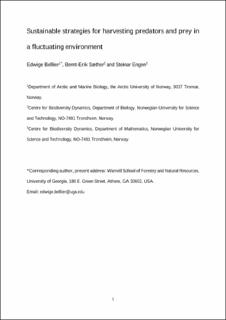| dc.contributor.author | Bellier, Edwige | |
| dc.contributor.author | Sæther, Bernt-Erik | |
| dc.contributor.author | Engen, Steinar | |
| dc.date.accessioned | 2022-03-28T15:01:28Z | |
| dc.date.available | 2022-03-28T15:01:28Z | |
| dc.date.created | 2021-01-27T17:20:37Z | |
| dc.date.issued | 2021 | |
| dc.identifier.citation | Ecological Modelling. 2021, 440 1-12. | en_US |
| dc.identifier.issn | 0304-3800 | |
| dc.identifier.uri | https://hdl.handle.net/11250/2988128 | |
| dc.description.abstract | The effects of harvest and fluctuating environment on inter-dependent predators and prey are complex and not well-known. We define a stochastic model where the predators and prey dynamically interact. The novelty of the model holds on the fact that predators and prey dynamics are simultaneously affected by correlated environmental noises. Interacting predators and prey are harvested using a proportional threshold harvesting strategy that accounts for stochastic population dynamics. Optimal yield of prey can be obtained with identical harvesting strategies when the predators and prey responded to the environment similarly (i.e., synchrony between species) and differently (i.e., asynchrony between species). Remarkably, our study demonstrates that two different harvesting strategies, the proportional harvesting strategy for the prey and the proportional threshold harvesting strategy for the predators, are needed to optimize the annual yield of predators and prey when both species are harvested simultaneously. Our study finds optimal strategies for harvesting interacting species affected by environmental variations (i.e., correlated noises) with parameters representing the joint dynamics of predators and prey at a stable state. | en_US |
| dc.language.iso | eng | en_US |
| dc.publisher | Elsevier | en_US |
| dc.rights | Attribution-NonCommercial-NoDerivatives 4.0 Internasjonal | * |
| dc.rights.uri | http://creativecommons.org/licenses/by-nc-nd/4.0/deed.no | * |
| dc.title | Sustainable strategies for harvesting predators and prey in a fluctuating environment | en_US |
| dc.type | Peer reviewed | en_US |
| dc.type | Journal article | en_US |
| dc.description.version | acceptedVersion | en_US |
| dc.source.pagenumber | 1-12 | en_US |
| dc.source.volume | 440 | en_US |
| dc.source.journal | Ecological Modelling | en_US |
| dc.identifier.doi | 10.1016/j.ecolmodel.2020.109350 | |
| dc.identifier.cristin | 1880667 | |
| dc.relation.project | Norges forskningsråd: 244647 | en_US |
| dc.relation.project | Norges forskningsråd: 223257/F50 | en_US |
| dc.relation.project | Norges forskningsråd: 223257 | en_US |
| dc.description.localcode | This is the authors' accepted manuscript to the article. Locked until 12/11-2022 due to copyright restrictions. The version of record is available online at: http://dx.doi.org/10.1016/j.ecolmodel.2020.109350 | en_US |
| cristin.ispublished | true | |
| cristin.fulltext | postprint | |
| cristin.qualitycode | 1 | |

